Poetry Is Not the Final Girl: Chris Chen
BY Trisha Low
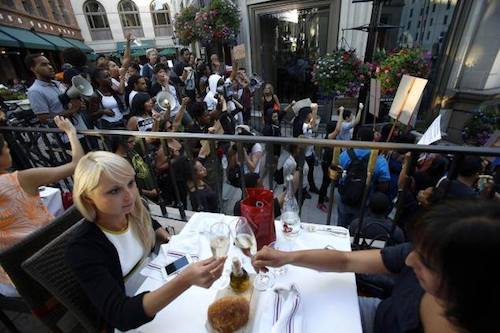
I haven't known Chris Chen for very long but something that I like to say about him is that he's a ringer. Well, ok. So I don't mean that Chris is very tall, or big, or that he's fraudulently won any athletic competitions recently, or participated in anything even approximating a boxing match that one might see in Million Dollar Baby or at the notorious East Bay Marxism vs: Nihilism party. I mean that he's one of the most generous spirited, level-headed intellectuals that I know. This is not to say that he doesn't want to take a stance, or that he doesn't have stakes either—he does, very fiercely—he hates capitalism and totally wants to, as he said laughing to me a few weeks ago, "kill whitey." But he also holds these opinions in a way that is consistently and meticulously crafted, refined and returned to in a way that holds others too.
It's probably not a good idea to say this but sometimes I think Chris might be a true mecha warrior in a wasteland of metaphorically weak ass power rangers even if they've all read the same Marx. And he's a ringer because when he's brought in to any discussion he has an incredible way of cobbling, connecting and re-assimilating what's being produced by disparate humans back into an informational mechanical armor that's built specifically to protect everyone inside the fold, but that's also going to mercilessly flatten everything we hate outside of it, no questions asked. So let's not fuck with Chris, ok?
Chris Chen is a poet and critic who writes on contemporary experimental writing and theories of comparative racialization. He's an Assistant Professor of Literature at the University of California at Santa Cruz. He has published poetry, essays, interviews, and reviews in The South Atlantic Quarterly, The Village Voice, Crayon, 1913: A Journal of Forms, and Endnotes.
~*~
TL: Let’s start with the most obvious, but also most telling question in honor of my favorite horror franchise, SCREAM: What’s your favorite scary movie? But also, why? Do you think this has any bearing on your aesthetic practice? And I do mean that in the most general of terms, since no one in this series identifies purely as a poet. Wait, do you?
CC: Yes, I still identify as a poet though I’ve kept much of the recent writing I’ve been working on to myself. It’s difficult to choose between some popular classics--Night of the Living Dead (1968), The Thing (1982)--or any number of recent East Asian horror films from Hideo Nakata or Takashi Shimizu. Ryûhei Kitamura’s Versus (2000) is incredible. The John Carpenter film is probably the closest we’ll get for now to an adaptation of H.P. Lovecraft’s “At The Mountains of Madness.” A little deeper into the archive there’s Carnival of Souls (1962) and Phantasm (1979). There have also been two fantastic and underappreciated recent horror westerns, Dead Birds (2004) and The Burrowers (2008). The original Swedish film version of the John Lindqvist novel Let The Right One In (2004) is probably one of my favorite horror films of the last decade.
But to pick a movie that’s not really considered a horror film, Luis Buñuel’s El Ángel Exterminador (1962). The film is set at a lavish dinner party in a mansion, where a group of well-to-do guests are prevented, by some seemingly supernatural force, from leaving a music room. As the days pass, a couple commits suicide, one guest dies, another has a nightmare about an aggressive crawling severed hand and has to stab it with a carving knife. Oh, and two sheep and a bear are roasted and eaten on a fire made from torn up floorboards. Of course this increasingly desperate group turns on itself as various attempts to escape fail, as the police and crowds of onlookers gather outside of the mansion, also unable to cross this invisible barrier that’s keeping everyone inside.
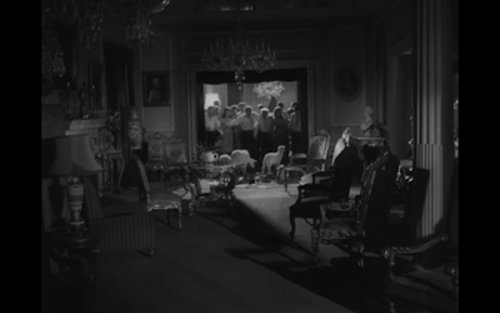
One of the guests realizes at some point that everyone is posed in the precise position when they first realized they couldn’t leave. She asks everyone to try and recall and repeat the conversations they were having, and of course this frees them. The movie plays like an extended Twilight Zone episode, but with better politics. It’s inventive and quite funny, especially because the characters are for the most part so vapid and try so desperately to cling to these utterly mechanical social scripts and roles. I think the whole fundamentally conservative fable like The Lord of the Flies (1954), El Ángel Exterminador (1962) was interesting to me because the “state of nature” in this case turns out to be a sort of sociopathic decorum maintained through abject clinging to arbitrary forms of social authority. Given more money, I think Buñuel might have made a movie closer in spirit to that Golding novel, but I’m glad he didn’t.
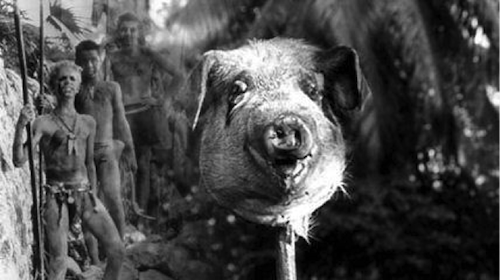
I guess the ending has had quite an impact on me, along with that severed hand, because the film manages to find so much humor in the empty formalism of the social milieu it’s depicting. The characters have to collectively reperform a precise sequence of gestures, leading up to the moment they first realized they were trapped, in order to inoculate themselves from whatever supernatural force is keeping them there. This may be an idiosyncratic reading, but for me this peculiar ritual seems to get at something about longstanding and equally peculiar aesthetic beliefs about how poetic form both models varieties of social constraints and sometimes helps to free us from them. But of course the film ends with a scene where the guests seem to go to a cathedral to give thanks and end up trapped there as well, while the military begins to shoot rioters outside on the streets.
TL: That’s my favorite Buñuel movie, actually. It’s interesting to me because there’s a number of rituals they try to carry out that are unsuccessful before they enact the banal social scripting that finally frees them. My friend Michael Tom kind of likes that predestinatory air of horror movies; the idea that there’s kind of a totally arbitrary sense to the way things happen. It’s not that this person is necessarily bad, it’s just that they’re going to die anyway. Which is different to the way the Buñuel operates, but this idea is what, I think, really contributes to the additional layer of claustrophobia even, or especially when they’re freed.
It’s interesting that although I ask you about horror movies specifically, you gesture more towards something that incorporates elements of horror into something that’s more like a social critique or places it in sharper relief. Do you feel like the flip side to horror is its total wastefulness, like the real B-movie sense of kitsch and cliche? Is that something you’re less interested in?
CC: Right there’s some mystical rite that ends up failing as well, but I guess I’m fascinated by the fact that the relief that the characters feel as a result of this moment of fleeting self-recognition or reflexivity simply imprisons them in another empty ritual. Whatever else this moment in the film signifies, I think it registers the limits of metacinematic irony, self-reflexivity, satire.
I’m not sure I entirely agree about the arbitrariness of horror film plotting—if anything the genre seems fairly rigid, or at least determined to work through variations of predictable plot elements or to turn up the intensity of the violence, gore, sadism, what have you. These days, I think the moral calculus of the 1980s slasher film has been completely scrambled. It’s no longer so surprising when a film severs the relationship between a character’s moral rectitude and their chances of survival. It’s almost the opposite with recent films—the characterization is usually so thin in these movies that when a minor character is suddenly given a marginally sympathetic backstory this usually means that their time is basically up. I mean the generic parameters are rigid enough that in Scream the horror film geek, played by Jamie Kennedy, can more or less predict the sequence of murders, etc.
Two friends of mine, Joshua Miller and Mark Fortin, have written a very funny and loving parody of 80s slasher films, called The Final Girls, which just recently played at SXSW, that’s at least partially inspired by Carol Clover’s theory of “the final girl” from Men, Women, and Chain Saws: Gender in the Modern Horror Film. The main characters in The Final Girls, who are literally trapped within a loop of something like one of the early Friday the 13th films, are familiar enough with the minutiae of the genre to try to survive by triggering slow motion sequences or musical cues for example.
As for kitsch and tackiness, I guess I’m more interested what does and doesn’t survive cultural translation in non-US films like Hausu (1977). I like Hausu, but the accumulation of absurdities sort of makes the whole thing go slack for me past a certain point. It starts to feel pretty frantic, empty, and stressful, which as Sianne Ngai and others have pointed out is a fundamental feature of the “zany” as an aesthetic category. I’m also interested in how what’s funny to US audiences about these cross-cultural quotations often verges on a sort of unintentional minstrelsy.
Domestically, one can also see a similar sort of pastiche of horror, fantasy and science fiction film tropes in Coscarelli’s Phantasm, where these different genres seem to confront and renew each other. So although in the film a hapless ice cream vendor has to battle tiny hooded reanimated corpses, who look suspiciously like Jawas from Star Wars, Coscarelli doesn’t stage these scenarios strictly for laughs. These scenes somehow manage to be schlocky and exciting at the same time.
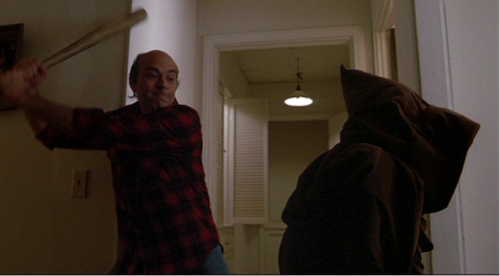
TL: My friend Arabelle and I discuss in her interview the difference between being-scary and being-scared as points of identification within horror movies. Because as small Asian girls, horror movies were kind of the first positive cinematic representations we had access to. And watching a horror movie as someone who identifies as the ghoul is very different than someone who is watching it who’s terrified of the ghoul. In that way horror is the realm of the marginal. But your point is more complex here—Hausu, definitely one of my all time favourite horror movies was based on Jaws (like, what?).
I mean, if Jaws is a kind of total mastery of genre, this perfectly timed and painted suspense and fright then Hausu in contrast is like its nauseatingly leprous cousin, so overgirded with the uncanny to the point that there are no longer any metrics for suspense or shock, or even finitude. Like, it obliterates every threshold. Which is opposite to those generic parameters that have become an obsession in US horror- the need to be more and more meta or internally referential (although I’ll admit I have a fondness for that a la Cabin In The Woods).
Sometimes I think Hausu kind of feels like a revenge fantasy. You’re right, I do think that what US audiences enjoy can border on minstrelry, but on the other hand, I think that they can be so culturally specific that US audiences can lose a lot, or can be ridiculed without their even noticing. We once talked about Battle Royale and how it feels like our experience of the film was necessarily different in some ways because of family history. Horror’s now become a contemporary genre that’s ruled by Korean and Japanese movies, even in the west. What do you think about the recent obsession (since The Ring) with Asian horror movies? Do you think we’re just better at horror movies? Do you feel it’s problematic, exoticising in some way, or can Asian horror launch some very real critique?
CC: I love Jaws (1975). I was pretty young when I first watched it, and seeing it again decades later it really struck me how elegantly plotted that film is. There’s not a wasted scene. I’m partial to how the entire Final Destination (2000-2011) series has reimagined these older slasher films by treating them as engineering problems, swapping out the axe-wielding maniac for the mathematical formula of who dies in what order. And the physics of gusts of wind, slippery surfaces, and everyday objects suddenly conspiring to form these elaborately lethal Rube Goldberg contraptions. The popularity of the series, with four sequels, seems at least partly due to audience schadenfreude about how the culture industry consumes this endless supply of aspiring teenage stars.

I think this Japanese horror renaissance (which gave way to a wave of Korean and later Thai and Indonesian horror films) you mention, from the late-90s to the mid-2000s, is more or less over. The new horror films coming out of Japan are kind of going through the motions, and Ryuhei Kitamura and Takashi Shimizu have gone on to make some pretty lackluster US films.
I think what you and your friend have have said about identifying with “being-scary” raises some questions about why Sadako from the Ringu series has managed to become a global phenomenon. One thing that’s pretty striking to me about the film and its sequels and prequels --which seem to take place in the same dysphoric, depopulated world as Kairo (2001)--is how the spirit of Sadako moves, and how her bones seem to break as she lurches around in this contorted, crabwise way. Her drooping, distended eye has obviously seen something from the bottom of a well of feminine abjection that’s incommunicable, but which has also invested her with this awesome ramifying, viral power. Her victims, all frozen in these Butoh grimaces, are all seemingly unable to survive the psychic transmission of an experience of patriarchal domination.
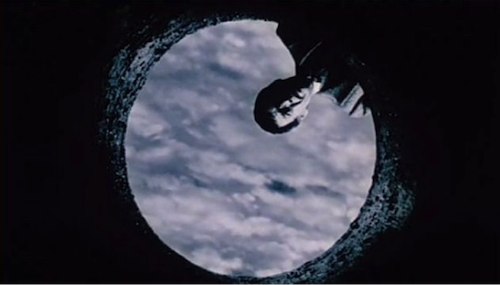
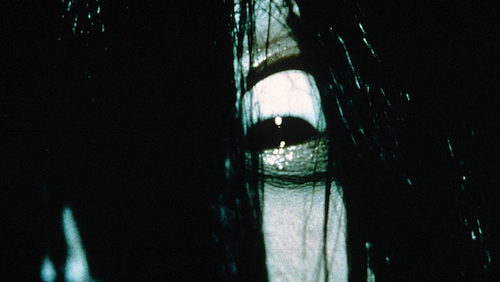
I know the vengeful female spirit is a figure who shows up in folktales across various cultures, from La Llorona or the figure of the Manananggal in Filipino horror. But Sadako is a peculiar combination of old and new fears. The story drops in a few hints that her father might be some kind of ancient, unpicturable Lovecraftian demiurge that rules over the ocean. At the same time she’s also a peculiar figuration of the aftermath of the 1997 Asian economic crisis. The franchise is obsessed with how social networks, including the nuclear family, can become “infected”--how networks don’t mitigate risk, deprivation, or patriarchal violence but instead spread it or displace it down a long chain of potential victims. And these victims are as isolated and trapped by circumstance as what has crawled out of a hole to murder them. What they see on these cursed tapes is not the past but the great disorder of the present.
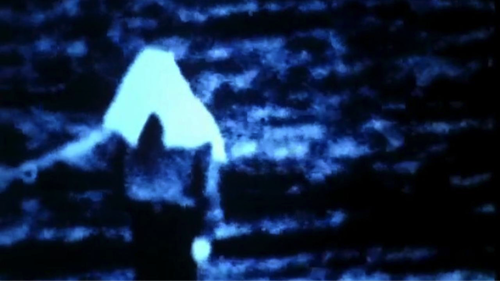
What’s especially interesting to me is how she’s clearly indifferent to a logic of individual moral culpability, punishment, and potential restitution. The debt is unpayable. I guess one could say that in the darkest region of the world of J-Horror, Sadako seems to represent the symmetrical, inverted figure of the final girl.
Which in a roundabout way brings us back to the cultural specificity of Battle Royale (2000). I think the film is amazing, but most of my Anglo-American friends were sort of put off by the peculiar combination of sentimentality and cartoonish violence. But these friends have been big fans of The Hunger Games (2012). Which is funny because I feel like The Hunger Games films relies on much a more sentimental critique of the disciplinary power of media spectacles. The differences between these two versions of what amounts to the same story is pretty interesting. Katniss Everdeen is meant to represent the purity and goodness of a traditional way of life. It’s Americana. And when the character sings the “The Hanging Tree” it exposes that way of life’s dependence upon a peculiar racial fantasy of what Saidiya Hartman calls the “fungibility of the captive body,” here vaporized by a political analogy. The film seems unable to represent organized political anger on its own terms without looking nervously aside, or coughing up this humorless, authoritarian, Cold War caricature--President Alma Coin. Clearly the surviving members of District 13 have stopped being just plain folks.
Before they form the armed militant group “Wild Seven” with the victors of previous games, the survivors of Battle Royale—Shuya and Noriko and Kawada—are fairly blank, stock characters. I think the movie is much more interested in the suicidal, self-consuming social logic of cliques. Most of the films I’ve named, from El Ángel Exterminador to Night of the Living Dead, could be read as fantasies about group formation in these fight or flight situations, where murderous impulses within groups are constantly displaced onto outside threats. Or where monsters at the door constantly emerge as strangers or scapegoats hidden inside the walled compound, the space station, the shunned house, the colony.
Battle Royale really relishes the Wagnerian grandiosity of high school social bonds formed through the murderous intensification of existing conflicts, jealousies, and exclusions. It could have been a musical. The class photograph which is shown at the beginning of the film seems to blur this sort of sickly sweet nostalgia for vanished youth with the pure culture of the death drive. That sort of tonal ambiguity is weirdly affecting to me. And it’s a very different sort of contest than The Hunger Games. Doing away with your competitors in Battle Royale is completely intolerable not because it’s unethical or a failure of empathy, but because acquiring a militant commitment to self-preservation is unbearably lonely.
That loneliness saturates the photo of Shiroiwa Junior High School Class B at the beginning of the film. It’s hard to tell what we’re looking at exactly when the film cuts between individual faces in a sea of identically dressed students. It’s a snapshot of a dissimulated, viciously hierarchical social ecosystem, but it’s also a memento mori colored by an intense, impossible desire for a kind of communal belonging that’s only achievable in death. The photo is a prophecy.
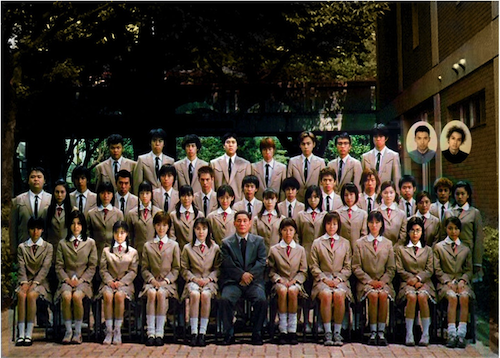
Which is to say I think this movie is about how one might idealize the experience of junior high school or high school precisely because it’s a self-cannibalizing, social Darwinist nightmare. Shuya and Noriko love each other, but they sort of figure out together that drawing a magic circle around the person they love in the middle of the game requires implicitly sanctioning the death of everyone else. I love how different their relationship is at the end of the film, when they figure out that these feelings hold out the promise of forms of sociality that the world doesn’t yet have a language for. Except “Run!” I found that moment tremendously hopeful and poignant, and especially because it segues into that delightfully cheesy pop song, whose title apparently translates into something like “Climb the Stairs of Quiet Days,” from Dragon Ash.
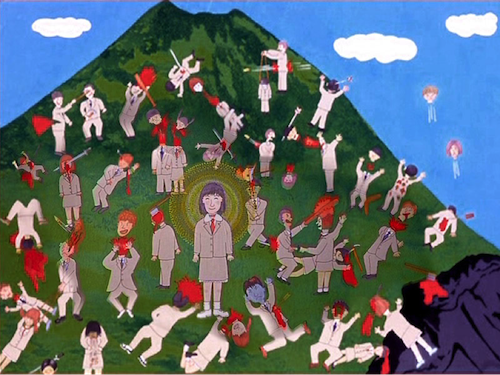
I think Battle Royale taps into a fairly class and culturally specific structure of feeling for those of us in the US who might fantasize about a sort of unlikely model minority mutiny. It was funny to see how the most recent Purge film, The Purge: Anarchy, actually restaged this Battle Royale or Hunger Games scenario as race war. Which is to say, I think this would be a perfect time to remake Peter Watkins’s Punishment Park (1971).
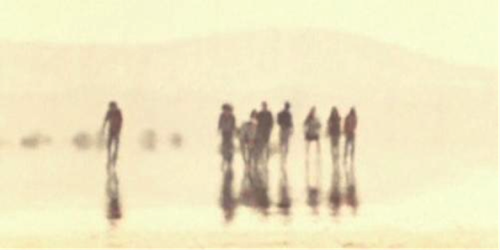
TL: I think the one thing that will always lure me in a horror movie is that one moment where the evil, whatever it is, whether just a dude in a mask with a knife, a zombie, a poltergeist, a possessed child, whatever, will exemplify a kind of non-specific terror that seems greater than the entire movie, or somehow exceeds the allegorical conditions that have been set by the film itself.
When you set self-preservation or survival against social formulations, things start to fall away, but then the question of individual vs. collective action simultaneously becomes intensified—the self-cannibalizing, gory moment is sometimes, paradoxically, the only mercy. I guess here’s a last question then—which is a joke but not really. Do you feel like poetry has something to learn from horror? Do you feel like it already is the implementation of a kind of horror? Or do you think that we should just throw in the towel and watch horror movies. Because I’m kind of all for the latter.
CC: Ah, this might be a long response. I think to me what you call eruptions of “non-specific terror,” which seems to dislocate tidy allegorical readings of these films, doesn’t mean these moments are completely sui generis. I guess what comes to mind are instances of non-specific humor like the hilariously gory, slipshod fight sequences from Riki-Oh: The Story of Riki (1991). Or brief musical interludes, inspired by Jean Marais’s descent into the underworld in Orphée (1950), from the vampire film Nadja (1994). In Nadja there’s a scene where Van Helsing describes this pixelvision image of Dracula with a stake in his heart by explaining in this deadpan way that “He was like Elvis in the end. Drugged, confused, surrounded by zombies.” It’s hysterical.
I think these traumatic or campy moments, which disorder the narrative forms which are supposed to bind these horrific creatures or wall off these primal scenes, perversely renew the pleasures of allegorical interpretation. At the same time I know these allegorical readings miss so much about the peculiar visceral specificity of these monsters and what they do. The twins from The Shining (1980) are so profoundly creepy they seem to resist being folded neatly back into the rest of the film. It’s not just that they’re ghosts, but that through violence they’ve been made into a hieroglyphic of psychic splitting, a chiasmus between two homicidal fathers. But still that’s not really a terribly satisfying explanation for how unnerving they are.
I think there are social referents for all this terror. What feels nihilistic or exuberantly transgressive about these films--or what one could maybe call the wasteful, non-purposive aesthetic autonomy of features of the horror genre--is a profoundly socially overdetermined and historically specific libidinal economy. Movies like Takeshi Miike’s Visitor Q (2001), Shin'ya Tsukamoto’s Tetsuo: The Iron Man (1989), or The Brood (1979) revel in how philias and phobias change places, but the monsters are fundamentally defined by the moral boundaries erected around the happy family, the good mother, procreative sexuality, normative bodies and genders etc. Otherwise we’d be indifferent to these images.
Which is why I think horror films can help us to think through the relationship between race and contemporary experimental writing, where race has consistently been imagined as thingification, a minstrel mask, the shrieking commodity, or what Hortense Spillers dubs the pre-symbolic, scourged “hieroglyphics of the flesh.” Race has come to signify the irrationality and givenness of matter shuddering beneath the shaping power of form and poetic abstraction.
So there’s been a decent amount of poetry which has attempted to make staples of the horror genre—the haint, the pitiless machine, the etheric double, the infected, the cartoon, the living statue, or the corpse—speak, stutter, sigh. To make these monsters mime or attack their makers. A figure emerging from a stain, a malevolent voice from a broken radio. From Poe to Lovecraft and beyond, the horror as a literary genre has been more or less explicitly motivated by racial animus and aversion, usually accompanied by profound self-loathing and barely disguised fears of miscegenation.
I know there’s a longer tradition here of writing which draws on some much older sources for modern horror films in everything from the book of Revelation to gothic fiction, from folktales to Federico Garcia Lorca’s theory of duende as a sort of singing wound. Of course this tradition, if we could call it that, isn’t limited to the US—from Georg Trakl, Antonin Artaud, and César Vallejo, to Sylvia Plath, Xi Chuan, and Kim Hyesoon. Most of the back catalog of Action Books, edited by Joyelle McSweeney and Johannes Göransson, seems pretty committed to exploring the sublimity of the grotesque.
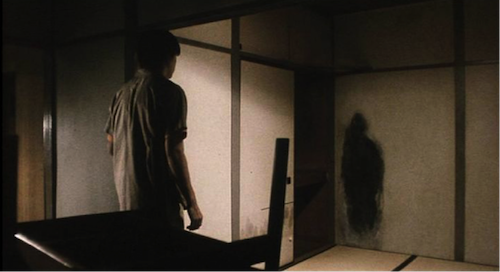
Quite a bit of the poetry I mention represent racially stigmatized populations as assemblages of the repulsive, disavowed waste products of contemporary social life. Flarf, the Gurlesque, the libidinal charge of the racist or sexist slur. Or writing which lives in the uncanny valley of assimilados, évolués, compradors, nerveless coolies, and sycophantic tour guides. To be clear, these are not equivalent impulses or projects. What constitutes experiment and “innovation” across these bodies of writing differs substantially.
Being an abomination is a powerful enunciative position, and I think a number of recent poets have really begun to interrogate what’s organic or affirmable about living “their whole life,/With this disease,” in the words of poet Cynthia Cruz. I’m thinking of incredible recent books like Dawn Lundy Martin’s Life in a Box is a Pretty Life or Douglas Kearney’s The Black Automaton, and writing by poets like M. NourbeSe Philip, Cristina Rivera-Garza, Dawn Lundy Martin, Bhanu Kapil, or Cathy Park Hong among others. Also Colson Whitehead’s recent novel, Zone One. Scapegoated, reviled populations are invested with enormous negative symbolic power, and I think many of these poets are often attracted to how a rhetoric of the aberrant can morph into this carnivalesque Rabelaisian abandon and abundance, and vice-versa. Or, in another register, this writing attends to the sound of what Fred Moten has called the “resistance of the object.”
Much of this recent work, I think, troubles the relationship between race and culture, and between culture and some easily paraphrasable and uniform set of political beliefs. I think conflating race and culture, or treating these terms as essentially interchangeable, ends up homogenizing varieties of antiracist politics as much as it requires policing the heterogeneity, unpredictability, and imaginative range of writing by nonwhite poets who clearly don’t share the same aesthetic orientation or political commitments. Most of the recent poetry that I’m interested in seems to manically overperform “race” as the cadaverous end product of racialization processes which consign the living to a kind of alternate dimension of everyday non-being or to a mausoleum of preconstituted, reified identities. A book like The Black Automaton seems fascinated by how when a voice possesses the dead forms of what Claudia Rankine calls the “racial imaginary,” seems to push that voice beyond the racial boundaries of cultural legibility.
There has been some powerful and provocative recent critical writing on antiblackness as a form of what Claude Meillassoux and Orlando Patterson have called “social death,” which I think attempts to address a contemporary crisis of racial representation which Martin and Kearney are also wrestling with. Critics like Frank Wilderson, Jared Sexton, and Joy James have been attempting to theorize antiblackness, not as a particular species of racism or primarily as a cultural identity, but as a constitutive feature of how we conceive of civil society in the first place.
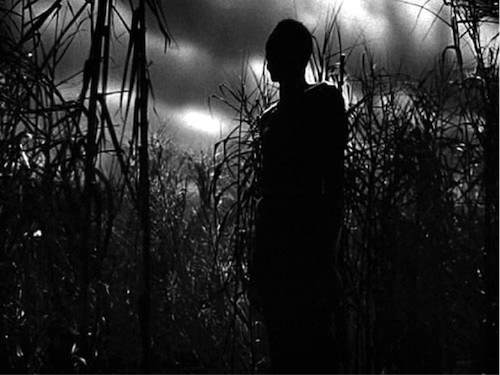
Most attempts to ironize or reframe these toxic discourses often just end up amplifying their effects and asserting whiteness as a radically indeterminate ordering power at a remove from race imagined as reified sociocultural “content.” Perhaps this is a roundabout way of saying that it’s been very rare for me to encounter poets--who haven’t themselves been targets of the violence and terror justified by these slurs, stereotypes, and powerful state narratives--who can handle racist and sexist language in ways that don’t simply reinforce the specific relationship between form and content that “race” presumes.
But racial hierarchies aren’t produced and reproduced primarily by poetry or slurs. I’m not convinced of the political efficacy of crafting sophisticated, elite forms of counterdiscourse which don’t accompany attempts to interfere with what E. San Juan Jr calls the “material infrastructure of the racial polity.” The racial imaginary, which is always at the same time a set of gender norms and rules governing social reproduction, isn’t primarily produced by discourse but by long histories of material inequality and domination. My sense is that in the absence of social movements on the scale of what we’ve witnessed over the last several years, investigation into the ensemble of social mechanisms which produce “race” has increasingly relied upon a liberal pluralist conception of culture synonymous with political unanimity.
The ostensibly “post-racial” era inaugurated by the election of a president has been partly defined by forms of cultural assertion and political representation which have been mobilized against structural transformation and less institutionally assimilable forms of contentious politics. I think this has resulted not in the expansion but instead in the drastic constriction of how the sphere of the political is imagined. I don’t want to be misunderstood here. I think that the communal bonds of care and political solidarity, and the rich traditions of cultural expression and construction, evolved partially in response to racial subordination are world making precisely because they establish a field of possibilities rather than the immutable properties of groups.
Which perhaps brings us back to the political limits of a reflexive acknowledgement of the power of rituals in El Ángel Exterminador (1962), especially in relation to “race” as a social form with a history and a comparative, hierarchical structure. Instead of serving as the basis of aesthetic autonomy or freedom, conceiving of “race” as form here also means reading it as a horrific morphology of social constraint--national borders, bantustans, blood quantum, severalty, penal architecture, “a cell with a view of evil parallels,” segregated cities, whiteness as property, shackles, a ship’s hold.
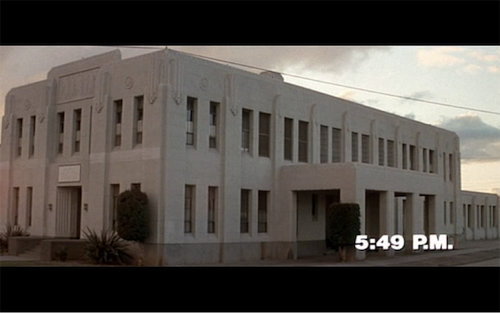
It isn’t surprising that “race” has continued to define the politics of Anglo-American poetic vanguards as well as mark the limits of their formal strategies. The stubborn antinomy of “identity” and formal innovation map political fractures which extend far beyond the boundaries of contemporary poetry debates. If the relation between the subjects and objects of experiment keeps getting bracketed or dismissed as “identity politics,” then the value-laden category of “form” in these discussions is going to continue to function like a chalk outline drawn around a body without perspective.
It’s an especially urgent problem considering that inherited taxonomies from earlier debates between what has been called “the politics of form” and what has been aggressively misread as a poetics of racial “identity” can’t account for the complexity of contemporary experimental writing by non-white authors, the depoliticization of formal innovation, and a militant activist poetics galvanized by recent antiracist and global anti-capitalist social movements.
These aren’t just obscure scholastic questions. Within recent social movements, from Occupy to the Black Lives Matter movement, serious rifts have emerged around strategies of political representation focused on exceptional leaders or in appeals based on “worthy,” morally unimpeachable subjects of empathy. Besides the persistence of timeworn aesthetic debates over the medium specificity of poetry, I think that the spectacular uncoupling of politics from form in contemporary poetry is also an index of how the representational logic used to institutionalize past US social movements is increasingly unable to contain the eruption of new ones.
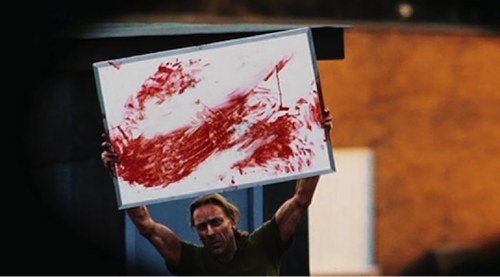
Poet Trisha Low is the author of The Compleat Purge (2013), and her work was featured in the anthology...
Read Full Biography

